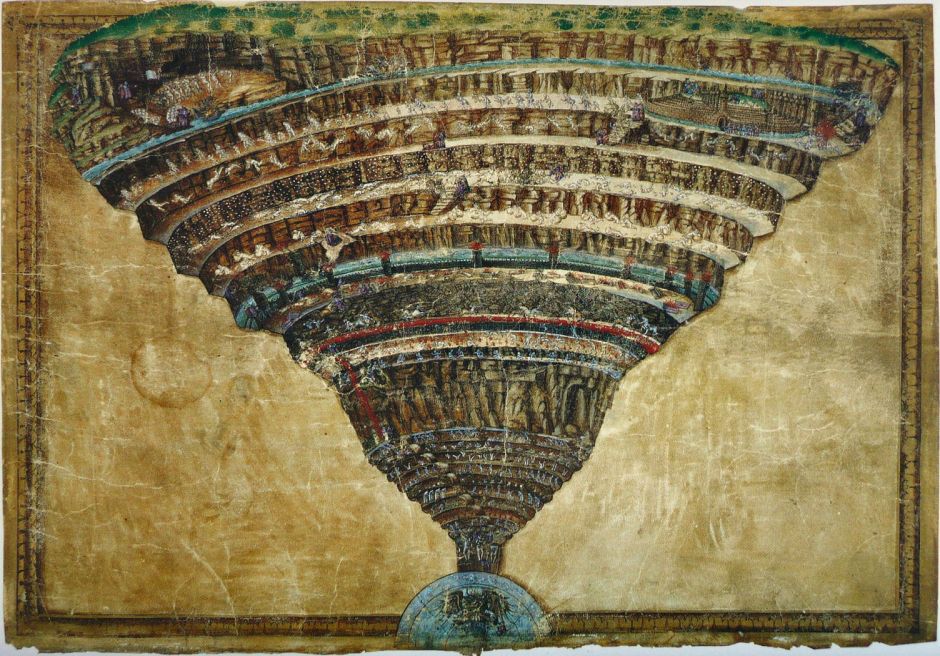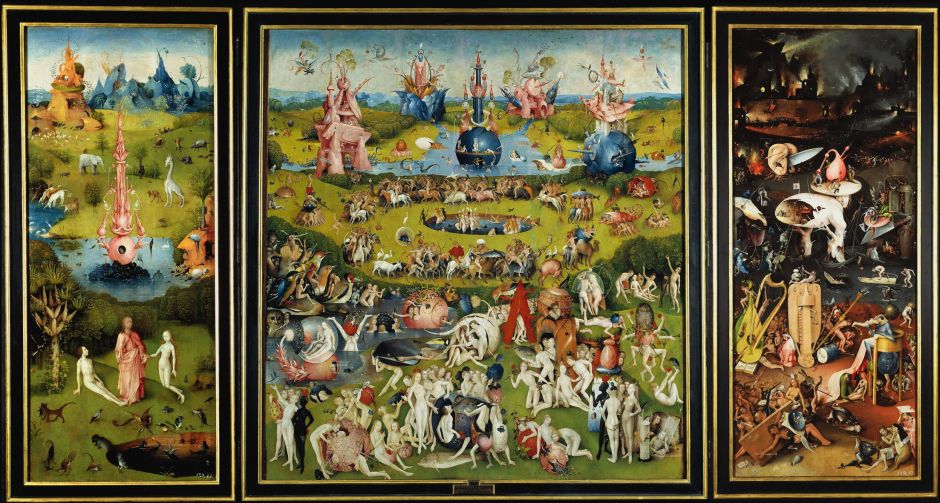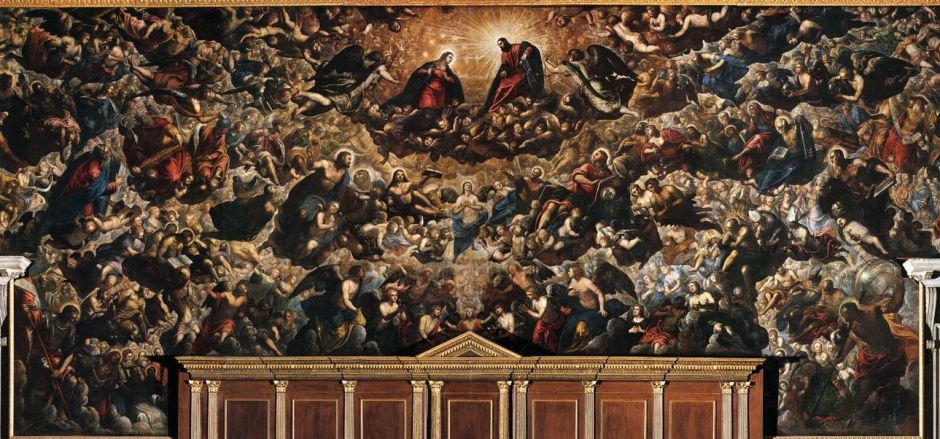It’s time for a break. In a year that had most of us already struggling by May, to have made it to November without an apocalypse seems quite an achievement. So this weekend I’m off to some legendary lands in the company of the late Umberto Eco, or at least his wonderfully eclectic The Book of Legendary Lands (2013). Grab your toothbrush and join us.

If you’ve accidentally brought along Botticelli’s Map of Hell then you can leave it behind. He created this in silverpoint with ink and distemper in 1480-90 when he worked on a set of illustrations for Dante’s Divine Comedy. Although I’ll be looking at Paradise a bit later, the aim this weekend is to escape from Hell.
Near the top of the list is Parnassus, which is a bit of a cheat as it’s a real limestone mountain which towers above the sacred site of Delphi in Greece.

In painting, though, Parnassus is almost wholly legendary, as seen in Andrea Mantegna’s painting, also titled Mars and Venus. Isabella d’Este’s first commission for her personal studiolo, it refers to the classical myth of the affair between Mars and Venus, the latter being married to Vulcan, who caught them in bed together and cast a fine net around them for the other gods to come and mock their adultery.
The lovers are shown standing together on a flat-topped rock arch, as the Muses dance below. To the left of Mars’ feet is Venus’ child Cupid who is aiming his blowpipe at Vulcan’s genitals, as the latter works at his forge in the cave at the left. At the right is Mercury, messenger of the gods, with his caduceus and Pegasus the winged horse. At the far left is Apollo making music for the Muses on his lyre.
At about the same time that Mantegna was painting that in tempera, Hieronymus Bosch was hard at work on what has become one of the most famous paintings of the Northern Renaissance, his triptych The Garden of Earthly Delights (c 1495-1505).

The left panel shows a unique vision of the Garden of Eden, an underlying theme to many of these images. On the right is a more terrifying apocalyptic vision which we’ll pass over, thank you. Sandwiched in between these Biblical references is a centre panel which comes straight from the artist’s wildest imagination.

Here’s a rolling deer park with lakes, which is overrun by a dense mass of naked men and women, and bizarre objects, as shown in the detail below.

The foreground contains a dense throng of people who are frolicking on grass with large fruit objects, including strawberries, blackcurrants, blackberries, apples, cherries, and others. Behind that on the left is a small lake, again densely packed with people and extremely large birds, including a kingfisher.
Back in Mantua, Isabella d’Este its Marchioness had commissioned more paintings for her private collection.

Among them was one which had originally been commissioned of Mantegna, but he had died before he could make much progress on it. It was Lorenzo Costa (1460–1535) who painted The Garden of the Peaceful Arts or The Crowning of a Female Poet (1504-06) in oil and tempera. Costa started from scratch, and under Isabella’s direction according to her poet’s literary theme produced this strange painting which is often known as an allegory of Isabella’s coronation, or construed as an account of Sappho’s career.
Figures identified include Diana, at the front on the right, and Cadmus, but reading this work coherently seems impossible now. Isabella’s garden looks peaceful until you look behind it to the left. Down by the river some knights are engaged in quite a punch-up for no apparent reason. Perhaps someone misunderstood the meaning of the word lute?

Niccolò dell’Abbate’s fresco in the Palazzo Torfanini in Bologna, Italy, shows a scene from the fifth canto of the hugely popular epic poem Orlando Furioso, by Ludovico Ariosto, which was finally published in complete form in 1532, less than twenty years before this painting was completed. Here, Ruggiero and a companion, mounted on unicorns, are arriving at the gate of an enchanted city. Ruggiero had flown there on a hippogriff, but the island turns out to be under the control of the evil sorceress Alcina.
We can take more comfort, perhaps, in the legendary lands of classical myth.

The frescoes of the Palazzo Ghisilardi Fava in Bologna give a superb account of the story of Jason and the Golden Fleece through eighteen separate images. Although this work was directed by Annibale Carracci, it’s thought that his brother Agostino and cousin Ludovico also made significant contributions during the painting, between about 1583-84.
This uses elaborate multiplex narrative to summarise much of Ovid’s account: at the left, two of the fire-breathing bulls are still yoked, in front of King Aeëtes. The army sprung up from the dragon’s teeth appear behind the wall, armed still with spears but no longer fighting.
In the foreground, Jason has put the dragon to sleep using Medea’s magic concoction, and is unhitching the Golden Fleece while he can. At the right, two of the Argonauts offer to help Jason (shown a second time) carry the fleece away from the land of Colchis, often claimed to be on the shores of the Black Sea.

That takes me on to Tintoretto’s last vast painting, seven metres (almost twenty-three feet) high and twenty-two metres (over seventy feet) across, showing Paradise (1588-92). This focusses on the Coronation of the Virgin, but was largely inspired by Dante’s description of Paradise.
The next century saw some of the finest paintings of legendary lands, in the form of idealised composites in Nicolas Poussin’s landscapes.

One of the best of these is his Landscape with a Calm from about 1651. I’m content to spend the rest of the day with the smoke from a distant fire curling peacefully up into its sky, as livestock saunter by the lake.
But there’s one last legendary land which we should reach before nightfall, the Garden of the Hesperides, the nymphs of evening and the rich light of sunset.

JMW Turner’s The Goddess of Discord Choosing the Apple of Contention in the Garden of the Hesperides (1806) is unusual for showing such an extensive landscape, and the visit by Eris to select the golden apple which was to be at the centre of the Judgement of Paris. This shows Eris as an older woman, dressed in a red skirt, in the centre foreground, choosing between two golden apples which have just been picked from the surrounding garden by the Hesperides.
Tomorrow we’ll travel further afield, and closer to the present.

